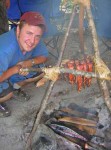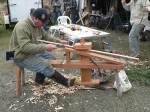I almost made my own fire-making video, but then I saw this great video by Peter Kummerfeldt who does a superb job explaining the best way to make a fire at Outdoor Survival-Chapter 9-Fire. The only thing missing from his explanation is that fire needs shelter. In fact, fire has the following 4 requirements:
- Fuel
- Air
- Shelter
- Ignition, which Peter describes as “heat” in his video. The second and third sections of my article below emphasize the need that fire has for shelter, something few people realize. First, watch Peter’s great fire-making video:
The Bed, Pillow & Blanket Method of Making Fire
If conditions are safe and easy and/or you have little time available in an emergency, then make a Bed, Pillow & Blanket Fire:
- The Baby: Gather the best fire making materials you can, and have three times more of every size than you think you will need. Start by gathering tinder, and think of it as a baby. If it is damp, or to keep it dry if it is not protected, place it inside the driest area of your clothing, such as a pocket, or between your inner and outer layers of clothing. Then gather everything else you’ll need for your fire, and have a stash of kindling ready for when you light it.
- The Bed: Consider wind direction, then position a minimum 1’x1’ wooden platform of sticks lined up to shelter your fire from the ground.
- The Pillow: Lay a 3” thick stick (or bundle of smaller sticks tied together) on one end of your platform, perpendicular to your platform sticks.
- The Blanket: Lean pencil-lead-sized pine twigs, dry grass stalks, or other material that will easily catch a flame on your 3” thick “pillow” to create a lean-to on top of your “bed” of platform sticks. Have extra “blanket” material ready, such as pencil-sized sticks.
- The Spark: Place your tinder under the blanket, and light the tinder with your match, lighter, firesteel, or other instrument. Add kindling in a criss-cross pattern described next.
The Conservation College Criss-Cross Fire Technology
Once your fire is lit, or if you only have a few hot coals that you want to flame back up, or if it starts raining/blowing/snowing, just maintain your fire with the not-patented:) Conservation College Criss-Cross Fire Technology which is similar to what Peter does near the end of the video above, but taking time to create optimal airflow:
- Lay about 5 or 6 of your thinnest / most flammable sticks PARALLEL next to one another, but with about ½ inch of space between them for air flow, on top of your coal or flames.
- Lay another 5 or 6 of your next thinnest sticks, still parallel to one another, but PERPENDICULAR on top of the first ones.
- Repeat with bigger and bigger sticks. This criss-cross fire technology creates perfect airflow, but insulates the fire by reflecting heat down to your coals which will heat up and spontaneously combust into flame.
The Tipi Fire: Still The Most Reliable in Severe Cold, Rain or Wind
If raining or cold and an hour is available, then a classic Tipi Fire may be required to get a fire started.
- Gather & Dry Tinder (in pockets or on body; know your flaming inner barks, grasses, coal extenders, etc.)
- Gather Branches with Pencil Lead, Pencil & Marker and place under natural shelter and on top of your gear or natural debris that’s not too wet.
- Dig Fire Pit and fill with rocks (must be dry on the inside so they don’t explode) if available. If not, use debris.
- Gather Large Wood & Build Outer Structure: Tipi, Lean-To-, Debris Hut or Log Cabin. Have door face the best direction for optimal airflow (so a gentle breeze will suck into the structure).
- Sweep leafy debris into fire pit to insulate it from the cold ground. The debris doesn’t have to be super dry, but it does have to create “lift” to trap dead air space which is what insulates.
- Place marginally dry marker-size sticks, bark or other material on top of debris insulation.
- Build Inner Tipi of “Pencil Lead” thickness sticks. Enhance with short whittled wood shavings.
- Build “Pencil Tipi: of pencil-thick sticks over the Pencil Lead Tipi. Enhance with long whittled wood shards.
- Build Marker-Sized Tipi over the Pencil-Sized Tipi. Enhance by splitting kindling with Knife-Bonk Method. (photo coming soon)
- Place any remaining kindling-sized wood that fits over the Marker-Sized Tipi inside the fire’s shelter.
- Light Fire. Getting flame (match/lighter/coal/flame) under tinder, and when coals develop, place gently under Pencil Lead. Watch and help fire, but if built properly under decent conditions, you shouldn’t have to blow or add wood at all until your structure falls.
- Add wood using criss-cross pattern over the coals whenever flame beins to die. And of course, never abandon a fire until the last coal is snuffed out and cool.
The Best Ways to Light Your Fire
Peter Kummerfeldt is absolutely right when he says we need to bring a reliable fire starter with us in order to be safe outdoors, and that it’s too hard for people to start fire by “rubbing 2 sticks together” if they haven’t learned how. He’s not right in saying that it’s too difficult to learn, however. My next blog post will demonstrate that anyone can learn to start traditional “fire by friction” using a “bow drill” just like they can learn any other method of starting a fire. But first, take a look at Peter Kummerfeldt demonstrating the firesteel, which he calls it a metal match, at
Chris Chisholm is founder and co-owner of Wolf Camp & School of Natural Science. For in-depth learning, join our Weekly Online Classes:
- Tuesday Classes focus on Herbal Medicine & Plant Crafts in the autumn season, followed by Gardening & Cooking Wild Edible Food Plants in the spring.
- Thursday Classes focus on Wilderness Survival & Bushcraft Skills in the Autumn Season, followed by Wildlife Tracking & Birding in the spring.
- Saturday Classes for all ages guide you through the Wolf Journey Earth Conservation Course – Book One: The Neighborhood Naturalist.












